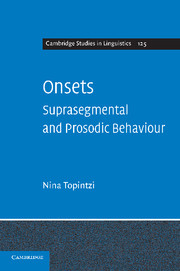Book contents
- Frontmatter
- Contents
- Preface
- Acknowledgements
- 1 Onsets and weight: the theory
- 2 Onsets and stress
- 3 Onsets and compensatory lengthening
- 4 Onsets and word minimality
- 5 Onsets and geminates
- 6 Other real and not so real onset-sensitive data: brief case-studies
- 7 Conclusion and discussion of alternatives
- References
- Subject index
- Language index
1 - Onsets and weight: the theory
Published online by Cambridge University Press: 06 July 2010
- Frontmatter
- Contents
- Preface
- Acknowledgements
- 1 Onsets and weight: the theory
- 2 Onsets and stress
- 3 Onsets and compensatory lengthening
- 4 Onsets and word minimality
- 5 Onsets and geminates
- 6 Other real and not so real onset-sensitive data: brief case-studies
- 7 Conclusion and discussion of alternatives
- References
- Subject index
- Language index
Summary
… no language has a rule stressing the penultimate syllable unless it begins with a voiced consonant, in which case one stresses the antepenultimate syllable
Hyman 1985: 96[Karo] stress can be predicted by the onset of the last syllable: if it is a voiced stop consonant, then the stress shifts one syllable to the left
Gabas 1999: 39Aims
This book explores the role of onsets in syllable-weight theory and consequently on prosody. In particular, I will be arguing that onsets, like nuclei and codas, can bear weight. Although this idea is one that has to be seriously considered by every phonologist interested in stress, weight and prosodic structure, it has nonetheless been overlooked. In fact, virtually all work on syllable structure and weight, the most prominent being Hyman (1985), Hayes (1989), Goedemans (1998), Morén (2001) and Gordon (2006, the published version of his 1999 thesis), maintains that onsets can never be weightful. However, in most cases, this claim is made purely by stipulation and for convenience, as e.g. Morén (2001: 8) also acknowledges: ‘Onsets are typically non-moraic. Although this is not the only logical possibility, it is convenient and I assume it here’ (emphasis added mine). The present book aims to fill this gap in the literature and challenge the standard assumption that sees onsets as weightless, offering fresh insights around this topic.
This comes in support of the recent marginal literature – basically Hajek and Goedemans (2003) and Gordon (2005) – that hesitantly admits some type of weightful onsets.
- Type
- Chapter
- Information
- OnsetsSuprasegmental and Prosodic Behaviour, pp. 1 - 36Publisher: Cambridge University PressPrint publication year: 2010

